Spring Fattoush Salad
This post may contain affiliate links. Please read my disclosure policy.

An attempt to make an authentic fattoush salad could easily send someone down the YouTube rabbit hole. I found myself nearly there a few weeks ago, when I remembered the exceptional fattoush salad my Lebanese friend Liliane made for lunch a few summers ago at her house.
It was simple, too: good tomatoes, cucumbers, and lettuce, good crispy pita bread, a simple dressing, a drizzle of pomegranate molasses, and a sprinkling of za’atar. I remember thinking: I could live on this salad.
The version featured here is not Liliane’s, but it includes many of the same elements. I bought the pita and pomegranate molasses from Nora’s Grocery in Albany, a spot Liliane has been encouraging me to visit for years. The shop in general is filled with goodies, but it’s worth the visit alone for the pita, which is flown in from Montreal every Thursday morning. (Incidentally, Nora, the owner, is as charming as ever, and I ended up walking away with a ball of her homemade cheese, a tub of her favorite labne, and a jar of rose jam, which Nora likes to eat with the labne spread across toast. More on this soon.)
Because tomatoes are not yet in season, I’ve altered the classic fattoush makeup, using slivered snap peas, radishes, and cucumbers instead, and I encourage you to do the same: use what vegetables you have on hand or that are currently in season.
If you stick to the basic fattoush formula: chopped fresh vegetables + lots of herbs + crispy pita + fattoush dressing, you’ll end up with something delicious no matter what. Let’s break down the fattoush elements:
Fattoush Salad Dressing
I’ve adapted my favorite shallot vinaigrette recipe to include garlic as well as sumac and pomegranate molasses, two ingredients typically found in fattoush salads. Sumac is not in fact a spice, but rather the ground berry of a shrub. It lends a unique acidic and lemony flavor. Pomegranate molasses is reduced pomegranate juice. It is thick in texture, like a syrup, and its sweet-sharp flavor is not unlike a reduced balsamic vinegar. Most bottles you find will have the addition of sugar, too. I am really loving the Cortas brand Nora recommended.
Because I love white balsamic vinegar, I’m using it here, but some or all of it could be replaced by fresh squeezed lemon juice, which may be more traditional. Use what you like. The exact proportions are included in the recipe box below, but here are the elements:
- minced shallots and garlic
- white balsamic vinegar (I like the Colavita brand)
- salt
- sumac
- pomegranate molasses
- olive oil
Fattoush Vegetables
Tomatoes and cucumbers are classic, but as noted above, use what is in season. Any of the below vegetables in any combination would be nice throughout the spring and summer.
- slivered snap or snow peas; slice them on the bias for a pretty presentation
- cucumbers
- radishes
- Romaine or other sturdy lettuce
- tomatoes
- thinly shaved fennel
- bell peppers
- thinly sliced red onion
- raw corn
- What else? Anything you would put in a chopped salad would work here.
Fattoush Herbs
Mint, for me, is essential, but any of the below herbs in any combination would be nice.
- mint
- chives
- parsley
- cilantro
- dill
- scallions (not really an herb, but herb-like in what it offers)
Fattoush Pita
- If you cannot find the above mentioned ARZ pita, use whatever you can find. The ARZ pita is very thin, and for this reason I don’t split it before toasting. If you are using thicker pita, split the rounds crosswise before toasting.
- The pita can be toasted without any oil or seasonings, but the oil and spices and salt make it so, so tasty. Here I’ve used cumin and crushed red pepper flakes, but any number of spices could work. Next time, I’m trying za’atar, which Lilian uses in her fattoush salad.
As noted above, this whole combination is not authentic, but authenticity is not the goal here. The sweet-sharp flavor of the pomegranate molasses along with the tart, lemony sumac in combination with all of the herbs and vegetables give this salad a brightness and liveliness that’s just irresistible.
After making the salad yesterday on Instagram Stories and posting the photo in my feed, I was so happy to see Liliane’s comment, which read: “The salad looks delicious and refreshing, which is what fattoush is all about.” Amen, Liliane. Amen.
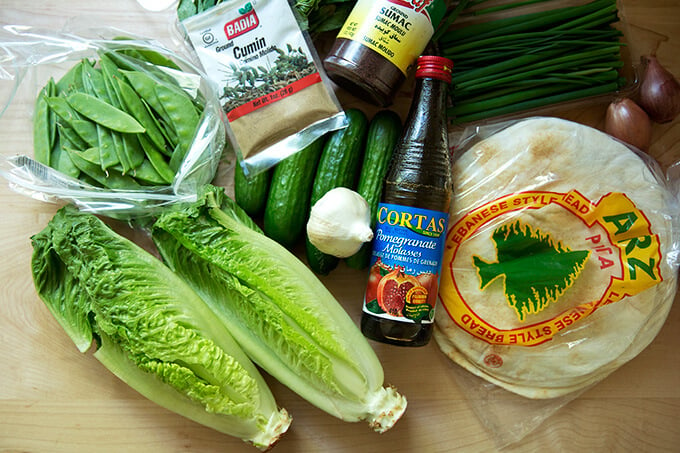
This is the pita that is flown in from Montreal every Thursday morning to Nora’s.
Brush it with olive oil, cumin, salt, and crushed red pepper flakes, if you wish.
Crispy pita = so good. This fattoush salad experiment has sent me on a little homemade-pita chip bender. My kids like them brushed with olive oil and salt. If you cut the pita into wedges before you toast them, you could make chips that are really nice to serve with hummus.
The two ingredients that give fattoush salad that unique sharpness and tartness: sumac and pomegranate molasses.


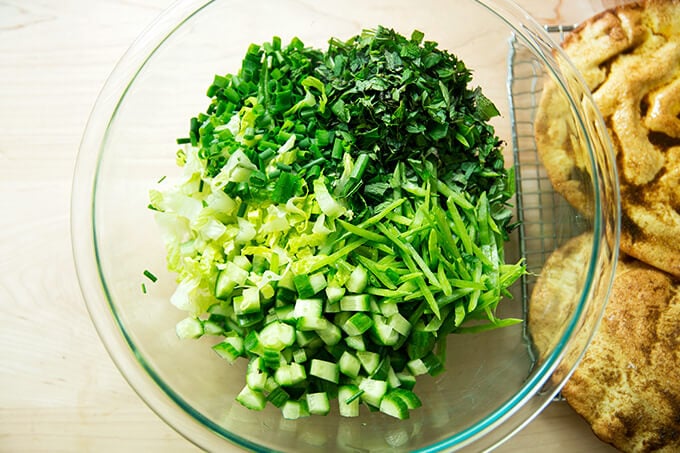

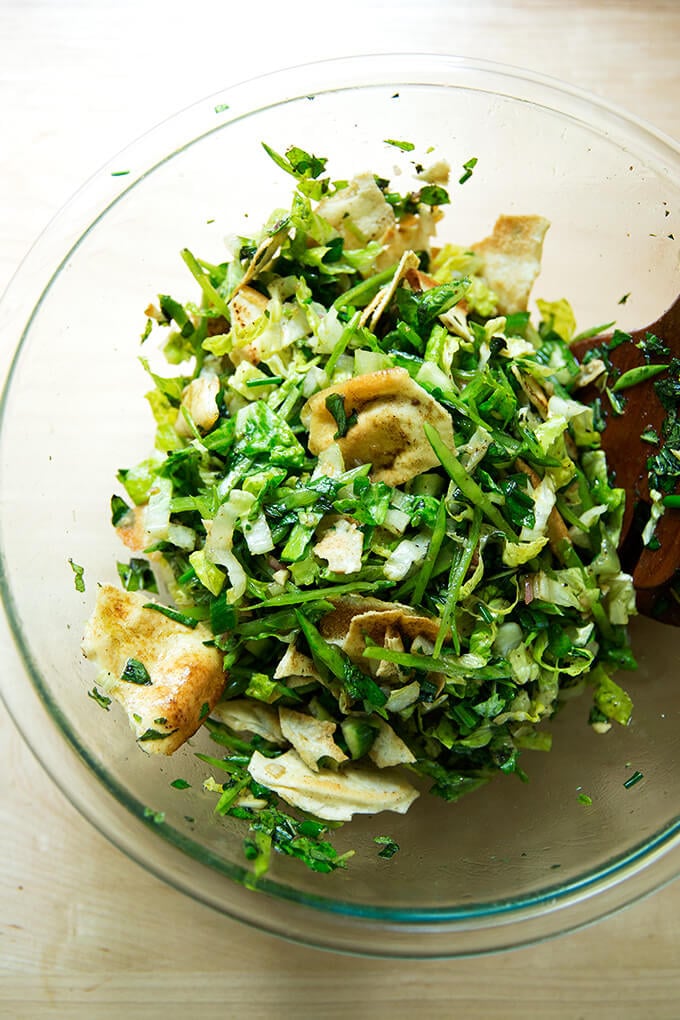
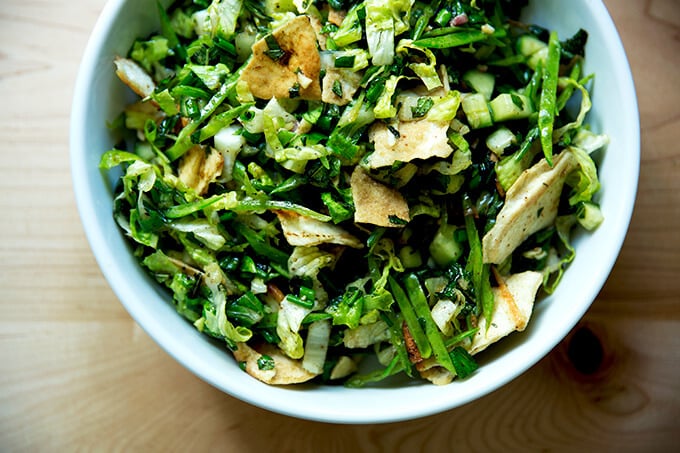

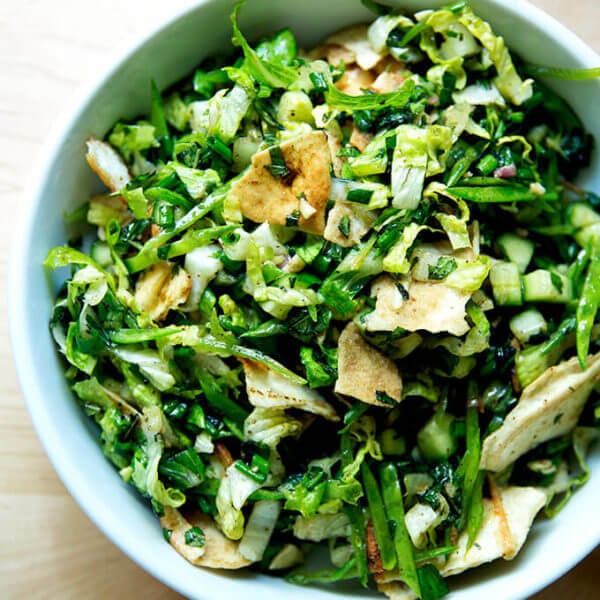
Spring Fattoush Salad
- Total Time: 33 minutes
- Yield: serves 4
Description
Notes:
- Use the recipe below as a guide. Come summer, I 100% will add tomatoes, but right now, this mix of snap peas, radishes, cucumbers, lettuce, and herbs, is doing the job. Use whatever vegetables and herbs you like and have on hand.
- The salad dressing is simply an adaptation of my favorite shallot vinaigrette with the addition of sumac and pomegranate molasses. It can be scaled up as needed.
- Not all pomegranate molasses are created equal. I bought this Cortas pomegranate molasses from Nora’s Market in Albany — Nora recommended this bottle, and I trust Nora. Because the sweetness/tartness/flavor of pomegranate molasses can vary from bottle to bottle, start with a tablespoon and add more to taste.
- Sumac can be hard to find. I see it more and more in shops and always in Middle Eastern markets, but if you have a hard time finding it, order a jar.
- This pita, (purchased from Nora’s Market, flown in from Montreal every Thursday), is very thin — separating it into two halves, in fact, is torture. Because of this, I don’t separate it — I simply leave it whole, brush it with olive oil and seasonings, and bake it. It works beautifully. If you are using thicker pita that is easy to separate, do so.
Ingredients
for the fattoush dressing:
- 1 small shallot, minced
- 1 clove garlic, minced
- 1/2 teaspoon kosher salt
- 1 teaspoon sumac
- 1/4 cup white balsamic vinegar
- 1 to 2 tablespoons pomegranate molasses
- 1/3 cup extra-virgin olive oil
for the pita:
- 2 rounds pita, see notes above
- 1 to 2 tablespoons olive oil
- 2 teaspoons ground cumin
- pinch crushed red pepper flakes
- kosher salt to taste
for the salad:
- 2 heads Romaine, finely chopped
- 4 small cucumbers, diced
- 1/2 lb. snap or snow peas, strings removed, sliced thinly on the bias
- 4 radishes, optional, thinly sliced
- 1/2 cup finely chopped chives
- 1 cup mint, finely chopped
Instructions
- Make the dressing. Place the shallots, garlic, salt, sumac and vinegar in a small bowl. Let stand at least 15 minutes. Add 1 tablespoon of the pomegranate molasses and the olive oil. Whisk to combine. Taste. Add another tablespoon of pomegranate molasses if you wish — I always use 2 tablespoons.
- Make the pita. Heat the oven to 400ºF. If you are using thin pita (see notes above), simply lay the two rounds of pita on a sheet pan. If you are using thick pita, separate each into two halves and place each half smooth side up on a sheet pan. In a small bowl, stir together 1 to 2 tablespoons of olive oil, the cumin, and the crushed red pepper flakes — if you are brushing the oil over only two halves, 2 tablespoons will feel like a lot of oil (but it’s delicious and I say go for it); if you are brushing the oil over four halves, it may not feel like enough. Adjust accordingly — you want the surface of the pita to be coated in the cumin oil. Season generously with salt all over. Transfer pan to oven and bake for 6 to 8 minutes — keep an eye on it! These quickly turn from perfectly toasty to overdone. Remove pan from oven and transfer pitas to a rack to cool.
- Make the salad: In a large bowl, combine all of the salad ingredients. Pour most of the dressing over top. Toss. Taste. Add more dressing — you’ll likely need all of it. Break the pita into shards over the salad. Toss again. Serve.
- Prep Time: 25 minutes
- Cook Time: 8 minutes
- Category: Salad
- Method: Toss
- Cuisine: Middle Eastern
This post may contain affiliate links. Please read my disclosure policy.

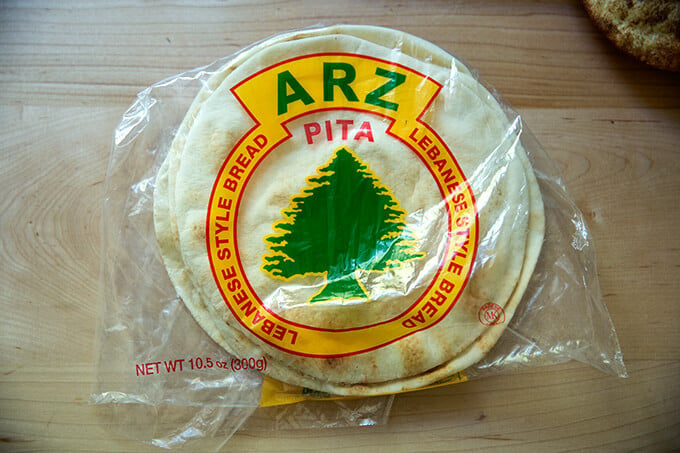

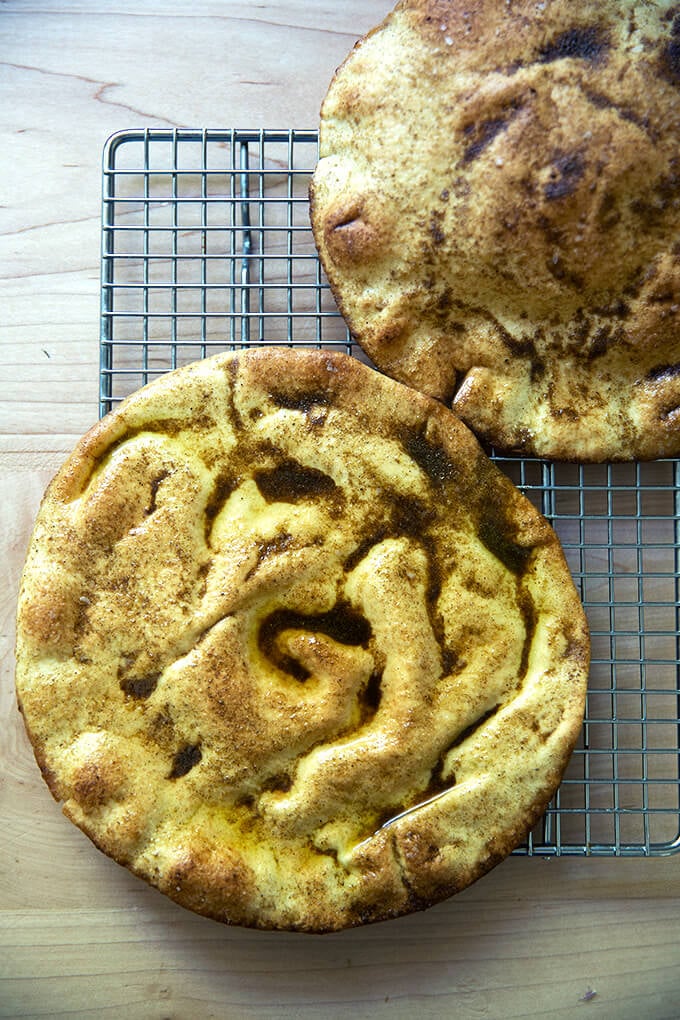






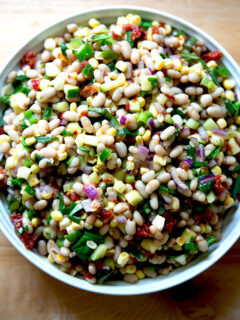





18 Comments on “Spring Fattoush Salad”
This was delicious! I used an orange bell pepper, snow peas, radishes tomatoes and red onion. The dressing was fabulous and we loved the pita- despite having pretty awful pita bread.
Thank you- as always!
So happy to hear this, Liesl!! Love the sound of your combination of veg. I love the idea of mixing this up all summer long 🙂
This was so great! This week’s CSA included a mix of greens, radishes, tiny kohlrabi and lots of herbs — and then I also added some green and white asparagus, chickpeas, and cherry tomatoes. Perfect springtime dinner.
Yay! Katie, I’m so happy to hear this! Hope you are well. It’s been too long!
Oooh, we are eating the same pita bread! I love that you can get ARZ down where you are.
This is a great recipe. I eat fattoush out a lot and sometimes want to make it at home, and have been down said recipe rabbit hole. Will just stick to yours from now on!
Yay! Hi Lucy!! So happy to hear this. ARZ is a recent discovery, and I have since been making weekly trips to Nora’s to get it … I should really stock up and freeze it … I think I just like visiting Nora 🙂 Hope you are well!
Best salad ever! The flavors of the dressing can’t be beat. I didn’t find ARZ pita bread but found another brand that was also thin pita. BTW, those pita chips are most amazing! I made extra and we just eat them like chips. They probably would be great with some labneh.
Yes to pita + labneh! So happy to hear all of this Edita! Glad you found some thin pita, too. 🙂 🙂 🙂
Wow. Wow. Wow. Wow. This salad is so good. I could have eaten all four portions. My goodness. I wouldn’t change a thing. Hubs thought some souvlaki or some other grilled protein might be fun on top. I served it as a first course to the Fish En Papillote (which was also fantastic) using sockeye salmon. Delicious. THANK YOU!
Yay! So happy to hear this, Andrea! Souvlaki on top sounds delish … love the idea of making it a main course salad. Thanks for writing!
Finally bought the Cortas and sumac to make this and it did it disappoint. Used tomatoes, romaine, lots of herbs, green onions and cucumber. Had to use naan instead of pita but it was still good! Had it with Greek grilled chicken and some tzatziki.
This all sounds amazing Jill! So great to hear 😍😍😍😍
sumac sub? I can’t find sumac where I am located; is there anything I can use as a sub?
Za’atar! Do you have that?? Sumac is an ingredient in za’atar. Or you can omit altogether. Or you can use some lemon zest – sumac has a tart flavor.
I loved this!!
Yay! Great to hear, Blair!
My family really enjoyed this salad. My only complaint is that it was a little difficult to eat because ingredients needed to be finely chopped. I will definitely make this again but I will cut the lettuce, cucumbers and snow peas into more manageable pieces. I also think that this salad could easily be stretched to serve 6 people although I do love a large serving of salad.
Great to hear! Thanks for writing and sharing your notes. A finer chop makes sense!